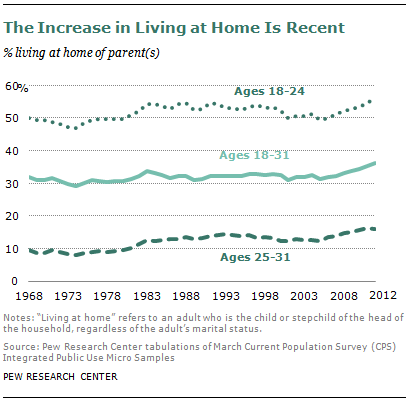 Since 2007, young adults have grown increasingly likely to live at home. This is a new trend.
Since 2007, young adults have grown increasingly likely to live at home. This is a new trend.
From 1981 (31%) until 2007 (32%), the share of young adults living with a parent remained largely unchanged.6 In 1968 (the earliest year comparable CPS figures are available), 32% of 18- to 31-year-olds lived at home.
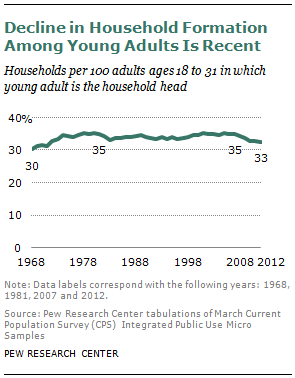 Similarly, the rate at which young adults form independent households also remained largely unchanged for much of the past 30 years. In 1981 there were 35 households headed by a young adult for every 100 young adults. In 2007, 18- to 31-year-olds formed households at the same rate of 35 households per 100 18- to 31-year-olds. Since 2007, household formation has declined, dipping to 33 households per 100 Millennials in 2012.
Similarly, the rate at which young adults form independent households also remained largely unchanged for much of the past 30 years. In 1981 there were 35 households headed by a young adult for every 100 young adults. In 2007, 18- to 31-year-olds formed households at the same rate of 35 households per 100 18- to 31-year-olds. Since 2007, household formation has declined, dipping to 33 households per 100 Millennials in 2012.
The long-run stability of residence with parents and formation of households has been accompanied by much larger shifts in other living arrangements of young adults. Young adults are delaying marriage.
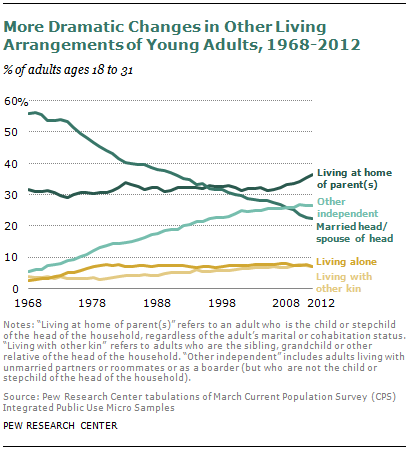 Since 1968, age at first marriage has increased by nearly six years for both men and women. Consequently, the share of young adults who are married and residing in their own household has plummeted since 1968. In 2012, only 23% of Millennials were married and residing on their own as household head or spouse, a precipitous decline compared with 1968 when 56% of 18- to 31-year-olds were married and on their own.7
Since 1968, age at first marriage has increased by nearly six years for both men and women. Consequently, the share of young adults who are married and residing in their own household has plummeted since 1968. In 2012, only 23% of Millennials were married and residing on their own as household head or spouse, a precipitous decline compared with 1968 when 56% of 18- to 31-year-olds were married and on their own.7
Young adults residing in “other independent living arrangements” has grown as married household arrangements have waned. Other independent arrangements largely consist of single parenthood, cohabitating couples, and simply living with roommates or as a boarder. The share of young adults residing in these other independent arrangements rose from 6% in 1968 to 27% in 2012.
18- to 24-year-olds
 From the mid-1990s until the mid-2000s, the share of 18- to 24-year-olds residing in their parents’ household declined slightly. During this period, more 18- to 24-year-olds were pursuing college. In 1997, 33% of this age group was enrolled in college. By 2007, 35% were in college.8 The movement of 18- to 24-year-olds out of the parental nest was being driven by non-college youth. The fraction of 18- to 24-year-olds not in college and living with mom and/or dad fell from 32% in 1997 to 29% in 2007.
From the mid-1990s until the mid-2000s, the share of 18- to 24-year-olds residing in their parents’ household declined slightly. During this period, more 18- to 24-year-olds were pursuing college. In 1997, 33% of this age group was enrolled in college. By 2007, 35% were in college.8 The movement of 18- to 24-year-olds out of the parental nest was being driven by non-college youth. The fraction of 18- to 24-year-olds not in college and living with mom and/or dad fell from 32% in 1997 to 29% in 2007.
Gender Trends
In 2012, Millennial males (40%) were more likely to live at home than Millennial females (32%).
This 8 percentage point gap in living at home is smaller than the 11-point gap evident in 1968.
The growing gender parity in likelihood of residing at home is especially pronounced among 18- to 24-year-olds. In 1968, 59% of male 18- to 24-year-olds lived at home (very similar to 2012). In contrast, in 1968 only 42% of females in that age group lived at home. So a 17 percentage point gender gap in living at home in 1968 has narrowed to a 9 percentage point gap in 2012 among 18- to 24-year-olds.
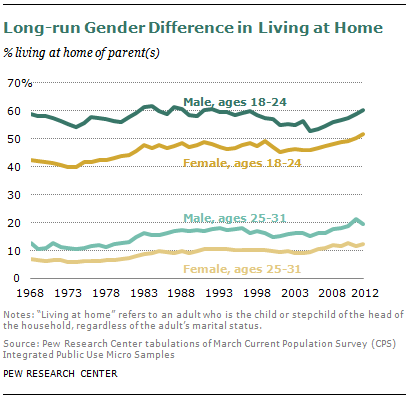 One factor that has contributed to the growing gender parity in living at home is the rise in the share of young women who go to college. (Goldin, Katz, and Kuziemko, 2006). In 1968, only 19.5% of 18- to 24-year-old females were enrolled in college in 1968, compared with 34% of their male peers. That ratio has since flipped; as of 2011, women were 6 percentage points more likely to be enrolled in college than men among 18- to 24-year-olds.
One factor that has contributed to the growing gender parity in living at home is the rise in the share of young women who go to college. (Goldin, Katz, and Kuziemko, 2006). In 1968, only 19.5% of 18- to 24-year-old females were enrolled in college in 1968, compared with 34% of their male peers. That ratio has since flipped; as of 2011, women were 6 percentage points more likely to be enrolled in college than men among 18- to 24-year-olds.
Accounting for the Characteristics of Millennials
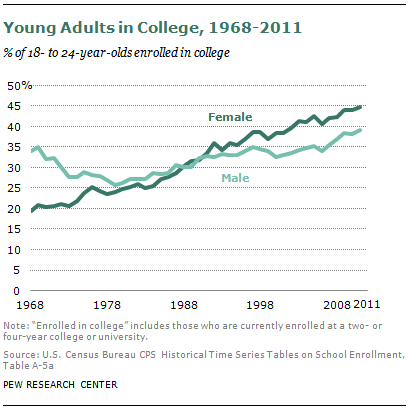 From 1981 to 2007, there was not much of an increase in the share of young adults living in the parents’ home . What about if we go back to 1968? Some of the Millennials are the children of the baby boomers, so it is of interest to compare the behavior of young adults in the new century to those of the late 1960s. As mentioned above, 32% of 18- to 31-year-olds lived at home in 2007. In 1968, 32% of 18- to 31-year-olds lived at home. So the raw statistics suggest that Millennials prior to the recession were no more likely to live at home than were young adults in 1968.
From 1981 to 2007, there was not much of an increase in the share of young adults living in the parents’ home . What about if we go back to 1968? Some of the Millennials are the children of the baby boomers, so it is of interest to compare the behavior of young adults in the new century to those of the late 1960s. As mentioned above, 32% of 18- to 31-year-olds lived at home in 2007. In 1968, 32% of 18- to 31-year-olds lived at home. So the raw statistics suggest that Millennials prior to the recession were no more likely to live at home than were young adults in 1968.
The simple statistics belie some fundamental differences between Millennials and the young adults of the later 1960s.
Age In 1968, 18- to 31-year-olds were members of the silent generation (born before 1946) and the early baby boomers (born 1946 to 1950). The baby boomers were a numerically large group, and so 18- to 31-year-olds back in 1968 skewed young.9 In 1968, 55% of 18- to 31-year-olds were in the younger 18-to-24 age group, compared with 2007, when only 50% of 18- to 31-year-olds were in the younger age group. So the simple comparison ignores the fact that Millennials are more likely to be older than young adults back in 1968.
One way to adjust for the older age of Millennials is to examine rates of living at home among narrower age groups of young adults. As the chart on page 10 shows, only 10% of 25- to 31-year-olds lived at home in 1968, compared with 14% of 25- to 31-year-olds in 2007.10
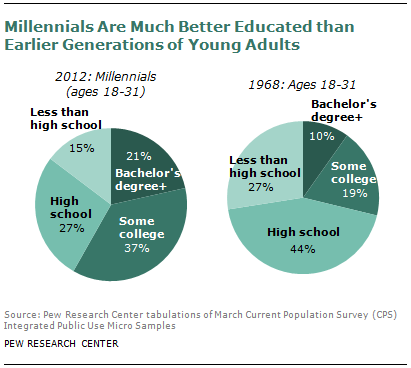 Education Another fundamental difference between Millennials and earlier generations of young adults is that Millennials are significantly better educated. In 2012, nearly 60% of Millennials had attained some education beyond high school. Measured at the same age as today’s Millennials, earlier generations of young adults were not nearly as likely to have some college education. For example, less than 30% of young adults in 1968 had attained any education beyond high school.
Education Another fundamental difference between Millennials and earlier generations of young adults is that Millennials are significantly better educated. In 2012, nearly 60% of Millennials had attained some education beyond high school. Measured at the same age as today’s Millennials, earlier generations of young adults were not nearly as likely to have some college education. For example, less than 30% of young adults in 1968 had attained any education beyond high school.
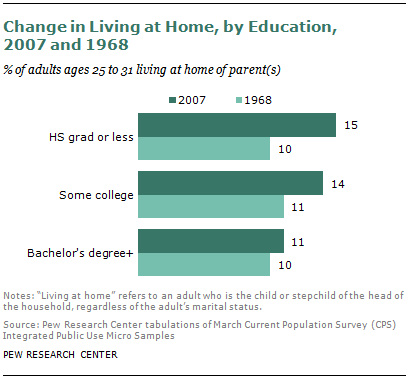 If we examine 25- to 31-year-olds of comparable education, the increase in living at home between 1968 and 2007 becomes apparent, especially among lesser-educated 25- to 31-year-olds. In 1968, only 10% of 25- to 31-year-olds who had not gone beyond high school lived with their parents. By 2007, however, 15% of similarly aged and educated young adults lived at home.
If we examine 25- to 31-year-olds of comparable education, the increase in living at home between 1968 and 2007 becomes apparent, especially among lesser-educated 25- to 31-year-olds. In 1968, only 10% of 25- to 31-year-olds who had not gone beyond high school lived with their parents. By 2007, however, 15% of similarly aged and educated young adults lived at home.


